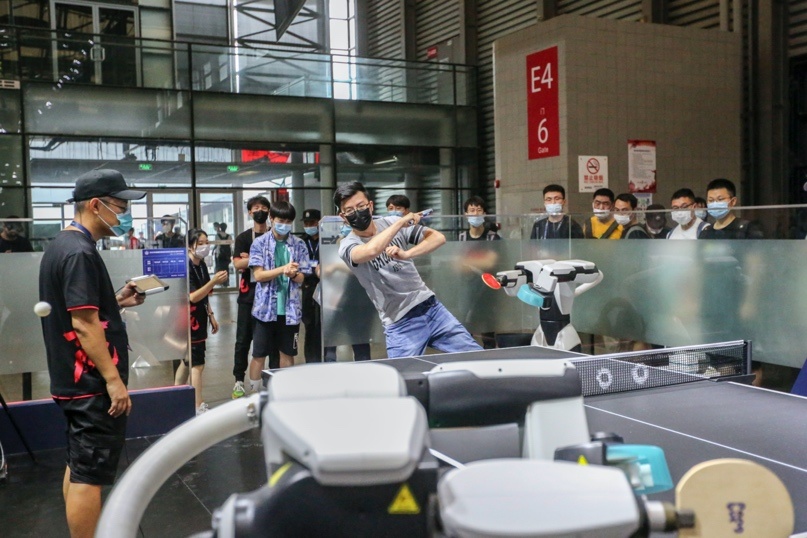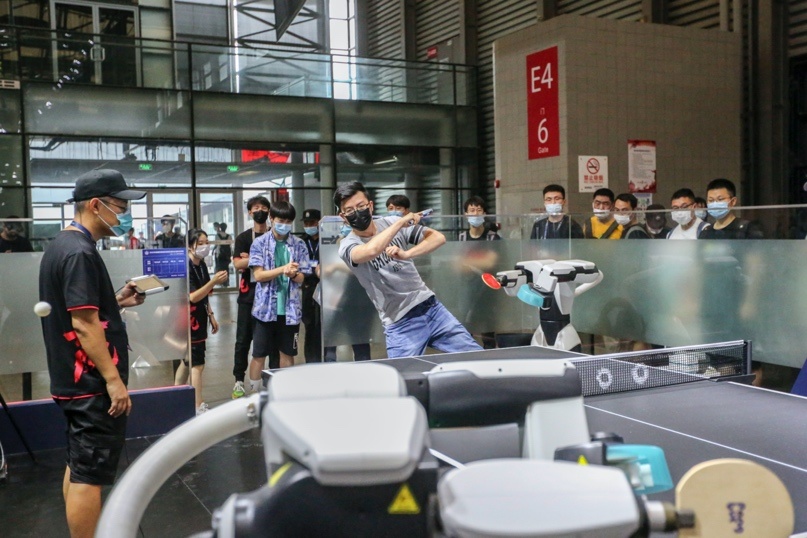By Tang Tianyi, People’s Daily

A visitor plays table tennis with a ping-pong robot Pong-bot at the ChinaJoy game event in Shanghai, July 31. (Photo by Wang Chu/People’s Daily Online)
How does it feel to have a robotic coach?
Recently, a row of ping-pong robots were seen using mechanical arms to serve at the training center of the China Table Tennis College of Shanghai University of Sport in east China’s Shanghai, while young players on the other side of the tables were preoccupied with hitting the balls with different landing points back.
These robotic coaches are ping-pong robots independently developed by Shanghai Pong-bot technology Co., Ltd. They were named Pang-bot, and have been put into the market in batches.
Japanese technology company Omron’s ping-pong robots displayed at the third China International Import Expo (CIIE) can also play table tennis with people.
The robots of Pong-bot and Omron use high-speed cameras to measure the movement of the ball and use artificial intelligence (AI) algorithms to predict the trajectory of the ball, creating more possibilities for table tennis.
When talking about the application of AI technologies in the sports industry, the battle pitting man against machine in the board game Go, known as Weiqi in China, is the subject of much discussion.
AlphaGo, Google DeepMind’s AI Go-playing program, defeated South Korean top professional Go player Lee Sedol and Chinese Go master Ke Jie in 2016 and 2017, respectively, surprising numerous Go players and fans.
With the in-depth application of AI technologies in the board game, AI Go-playing programs have been used to boost players’ performance.
In April this year, the Chinese national Go team renewed its contract for another three years with Chinese tech giant Tencent’s AI Go program FineArt.
Go players can improve their skills via AI Go programs in the whole process from the opening moves, actual combats, pre-match preparations to post-game review, while helping the latter improve their performance.
It’s the Go game that benefits most from the games between man and machine. Progressing with AI, the game of Go has added new contents and scenarios to the application of new technologies in the new era. At the same time, the Go games between coaches and players will finally lead to more accurate and efficient application of AI in the board game.
For a very long time after the debut of AlphaGo, AI-based Go software had been just a research program of tech giants. Now, ordinary Go fans can also use such Go software. Individuals have also developed similar software for public sale or open-source software that can be downloaded by all. Some Go fans who know about relevant technologies even adapt software by themselves.
The shortage of competent Go teachers, which used to plague the Go training industry, has also been alleviated because of the application of AI in Go teaching.
The AI-empowered curriculum system that has emerged in recent years has fully stimulated young people’s interest in learning the Go game and made it possible to improve their skills in a relatively short period of time.
AI has been applied in every link of the Go game, including competition, learning, training, research, and instructions, becoming a tool to unleash human potential.
Today, AI robots are already not news in the sports industry, and many people have already played against them.
During the 12th Guangxi Sports Festival that kicked off in south China’s Guangxi Zhuang autonomous region in August, many badminton enthusiasts played against an AI-empowered badminton robot that held a racket in its hand.
AI has also brought about new possibilities to professional sports in other aspects, such as assisting judges, replacing reporters in writing formalistic sports news, and helping fans to find more suitable seats.
It is conceivable that AI will be applied in more scenarios in the sports industry in the future. By actively embracing scientific and technological development and enabling AI to better serve the sector, the integration of science and technology into sports will surely create more fruits.
Recently, a row of ping-pong robots were seen using mechanical arms to serve at the training center of the China Table Tennis College of Shanghai University of Sport in east China’s Shanghai, while young players on the other side of the tables were preoccupied with hitting the balls with different landing points back.
These robotic coaches are ping-pong robots independently developed by Shanghai Pong-bot technology Co., Ltd. They were named Pang-bot, and have been put into the market in batches.
Japanese technology company Omron’s ping-pong robots displayed at the third China International Import Expo (CIIE) can also play table tennis with people.
The robots of Pong-bot and Omron use high-speed cameras to measure the movement of the ball and use artificial intelligence (AI) algorithms to predict the trajectory of the ball, creating more possibilities for table tennis.
When talking about the application of AI technologies in the sports industry, the battle pitting man against machine in the board game Go, known as Weiqi in China, is the subject of much discussion.
AlphaGo, Google DeepMind’s AI Go-playing program, defeated South Korean top professional Go player Lee Sedol and Chinese Go master Ke Jie in 2016 and 2017, respectively, surprising numerous Go players and fans.
With the in-depth application of AI technologies in the board game, AI Go-playing programs have been used to boost players’ performance.
In April this year, the Chinese national Go team renewed its contract for another three years with Chinese tech giant Tencent’s AI Go program FineArt.
Go players can improve their skills via AI Go programs in the whole process from the opening moves, actual combats, pre-match preparations to post-game review, while helping the latter improve their performance.
It’s the Go game that benefits most from the games between man and machine. Progressing with AI, the game of Go has added new contents and scenarios to the application of new technologies in the new era. At the same time, the Go games between coaches and players will finally lead to more accurate and efficient application of AI in the board game.
For a very long time after the debut of AlphaGo, AI-based Go software had been just a research program of tech giants. Now, ordinary Go fans can also use such Go software. Individuals have also developed similar software for public sale or open-source software that can be downloaded by all. Some Go fans who know about relevant technologies even adapt software by themselves.
The shortage of competent Go teachers, which used to plague the Go training industry, has also been alleviated because of the application of AI in Go teaching.
The AI-empowered curriculum system that has emerged in recent years has fully stimulated young people’s interest in learning the Go game and made it possible to improve their skills in a relatively short period of time.
AI has been applied in every link of the Go game, including competition, learning, training, research, and instructions, becoming a tool to unleash human potential.
Today, AI robots are already not news in the sports industry, and many people have already played against them.
During the 12th Guangxi Sports Festival that kicked off in south China’s Guangxi Zhuang autonomous region in August, many badminton enthusiasts played against an AI-empowered badminton robot that held a racket in its hand.
AI has also brought about new possibilities to professional sports in other aspects, such as assisting judges, replacing reporters in writing formalistic sports news, and helping fans to find more suitable seats.
It is conceivable that AI will be applied in more scenarios in the sports industry in the future. By actively embracing scientific and technological development and enabling AI to better serve the sector, the integration of science and technology into sports will surely create more fruits.
 Menu
Menu
 Application of AI in sports industry yields great fruits
Application of AI in sports industry yields great fruits
















